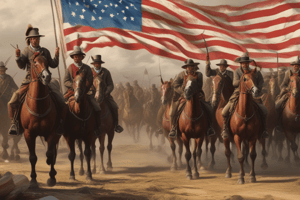Podcast
Questions and Answers
When did the Reconstruction era in America begin?
When did the Reconstruction era in America begin?
- April 9, 1865 (correct)
- May 5, 1863
- April 12, 1861
- July 1, 1864
Who succeeded President Abraham Lincoln and took on the Reconstruction movement?
Who succeeded President Abraham Lincoln and took on the Reconstruction movement?
- President Andrew Johnson (correct)
- President Rutherford B. Hayes
- President Ulysses S. Grant
- President James Buchanan
When did the Reconstruction era in America end?
When did the Reconstruction era in America end?
- April 15, 1875
- March 31, 1877 (correct)
- May 5, 1866
- June 10, 1871
What impact did the end of the Reconstruction era have on African Americans?
What impact did the end of the Reconstruction era have on African Americans?
What effect did the Plessy v. Ferguson decision have on Southern states?
What effect did the Plessy v. Ferguson decision have on Southern states?
How did the power shift in federal office impact the Reconstruction era's damage?
How did the power shift in federal office impact the Reconstruction era's damage?
What challenges did freedmen in the North face when seeking employment?
What challenges did freedmen in the North face when seeking employment?
How did housing policies and practices affect African Americans?
How did housing policies and practices affect African Americans?
What happened to many Radical Republicans in office as the Reconstruction era ended?
What happened to many Radical Republicans in office as the Reconstruction era ended?
What was the primary goal of Ulysses S. Grant as president?
What was the primary goal of Ulysses S. Grant as president?
Which amendment did Grant support the passage and ratification of in 1870?
Which amendment did Grant support the passage and ratification of in 1870?
What event marked the end of Reconstruction?
What event marked the end of Reconstruction?
Who succeeded President Lincoln after his assassination?
Who succeeded President Lincoln after his assassination?
Which legislation curtailed Johnson's control over reconstruction?
Which legislation curtailed Johnson's control over reconstruction?
Who was the last president involved in the Reconstruction era?
Who was the last president involved in the Reconstruction era?
Flashcards are hidden until you start studying
Study Notes
Reconstruction Era: Goals and Presidential Leadership
- Reconstruction period aimed to reunify the South and North after the Civil War, while addressing the fate of freedmen and safeguarding their rights.
- President Lincoln's 10 Percent Plan required Southern states' compliance for reunification, offering an olive branch to Confederates before the war's conclusion.
- Lincoln fought for the creation of the Freedmen's Bureau and the 13th Amendment to abolish slavery.
- Lincoln's assassination led to Vice President Andrew Johnson's presidency, who pursued a milder approach to Southern reconciliation, angering Radical Republicans.
- Johnson's Presidential Reconstruction led to the creation of racist codes in the reunified Southern states, enraging Radical Republicans in Congress.
- Radical Republicans curtailed Johnson's control over reconstruction by enacting the Freedmen's Bureau, the Civil Rights Act of 1866, and the 14th Amendment.
- The Tenure of Office Act was passed to restrict Johnson's ability to remove members of his own cabinet.
- Johnson's speaking tour during the 1866 congressional elections was a failure, leading to his impeachment in 1868, though he was not convicted by the Senate.
- Ulysses S. Grant, the last president involved in the Reconstruction era, had previously served during the Civil War and was present at General Lee's surrender.
- Grant's presidency marked the conclusion of the Reconstruction period, with the goal of reunification largely achieved.
- The Reconstruction era involved conflict between the executive branch and Radical Republicans in Congress over the process of reunification and extending rights to freedmen.
- The Reconstruction period saw the passage of key legislation such as the 13th and 14th Amendments, the creation of the Freedmen's Bureau, and the curtailment of presidential power through the Tenure of Office Act.
Studying That Suits You
Use AI to generate personalized quizzes and flashcards to suit your learning preferences.




